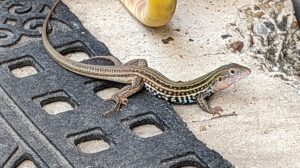By KATHY RAINES
The long-tailed, striped lizard, its limbs splayed out like a gecko’s, suddenly materialized on the porch as I swiveled back from watering the birds.
Snapping photos, I crept towards its tail end as the whiptail weighed its options: whether to bolt under an inch-wide crevice between porch and brick or keep still, undetectable and undevoured. Within seconds, it repositioned itself, then vanished. Unlike its neighbors, our resident brown and green anoles, this active forager sprints in stop-and-start bursts; it doesn’t pose for pictures.
We inhabit lizard paradise, even in residential neighborhoods. I’ve seen five species in my Brownsville backyard this summer— Texas spotted whiptails, brown and green anoles, Mediterranean geckos and Texas spiny lizards.
The Texas spotted whiptail, also called common spotted whiptail (Aspidoscelis gularis) thrives in deserts, grasslands and our own semi-arid thornscrub throughout most of Texas, minus the eastern half and some of the trans-Pecos and the Panhandle, as well as parts of Oklahoma, New Mexico and Mexico. Spanish-speakers call it huico pinto del noreste (painted whiptail of the northeast) or huico texano.
Seven or eight dorsal stripes, usually greenish, line this whiptail, with pale spots dotting the dark portions between them. Its colors allow for camouflage, long legs grant it speed, and an air-resistant, streamlined body, equals agility. The throat of the larger, mature male is pink or orange-tinted, and its venter, or underside, is bluish or blue-black. A female’s belly and throat are plain, while a juvenile, whose stripes are more distinct, lacks spots in the dark portions and wears a reddish tail.
This whiptail reaches from about six and a half to 11 inches, including its conveniently long, usually reddish-colored tail, which contains stores of fat and provides the balance required for quick maneuvers. During combat, its tail, like those of many lizards, may snap off, leaving a frustrated predator clutching that mere remnant in its claws or beak. Still, its tail is precious; it regenerates, but the spare is shorter, stiffer and more brittle, increasing its vulnerability.
Especially in the summer at Sabal Palm Wildlife Sanctuary, I see scores of Texas spotted whiptails crisscrossing in dashed diagonals, constantly hunting, but also evading their many predators, including snakes, roadrunners and hawks—especially the gray, with its penchant for lizards. They’re also snacks for great-tailed grackles, great kiskadees and several aquatic birds.
Probing with its snout and sometimes forelimbs, this whiptail, aided by its flickering, scent-detecting tongue, scours grass, dirt and leaf litter for grasshoppers, termites, beetles, spiders and larvae, its prey providing most of its hydration. It also eats some leaves and blossoms, including dandelions.
Want the whole story? Pick up a copy of the South Padre Parade, or subscribe to our e-Edition for FREE by clicking here



Comments